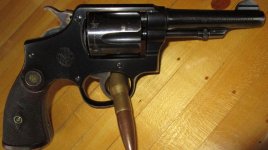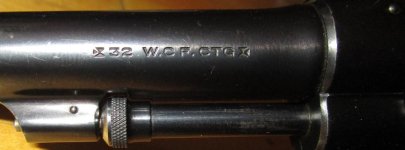I recently acquired what I believe to be a .32-20 Hand Ejector Model of 1905 4th Change, s/n:68856. I am seeking confirmation, or correction(s) on the identity of this revolver. The last 4 digits of the s/n are penciled on the inside of a grip panel. Thanks!
You are using an out of date browser. It may not display this or other websites correctly.
You should upgrade or use an alternative browser.
You should upgrade or use an alternative browser.
Looking For .32-20 ID Confirmation
- Thread starter Martyk
- Start date
Register to hide this ad
cgt4570
Member
You are correct.
Yours most likely shipped a couple years before the U.S. entered WW1. Someone else might be able to narrow it down more.
Yours most likely shipped a couple years before the U.S. entered WW1. Someone else might be able to narrow it down more.
Not sure but I think around 1915 for your HE. Someone will come here and be more exact than I am. Yours is not heat treated, believe that started around 85000 serial number. Doesn't seems to matter, there is a lot of metal on the cylinder.
Nice to see one in good nick! How is the bore?
Mine from 1908.
Nice to see one in good nick! How is the bore?
Mine from 1908.
Attachments
Yes. It is a pretty decent Winchester Model that likely shipped in 1916, based on nearby serial numbers. Dating these is always an
"educated guess" at best, but in that serial range there seems to be a fair amount of consistency.
The stocks are clearly period correct and with the penciled serial number can be considered original. I'd bet the initial 6 is actually there, but very hard to see.
"educated guess" at best, but in that serial range there seems to be a fair amount of consistency.
The stocks are clearly period correct and with the penciled serial number can be considered original. I'd bet the initial 6 is actually there, but very hard to see.
OP
Thanks for all the information. The bore is bright & shiny with strong rifling. There is a bit of holster wear on the sides of the barrel extending app. 3/8"-1/2" back from the muzzle. One aspect I'm curious about is on the cylinder stop slots. There is a extremely slight burr on the fully squared (stopping/following) side of the slot. It is barely perceptible with a fingernail. This is the first time I've run across this. Any theories as to what caused this burr/mushrooming? Since this cylinder was not heat treated, is there a safe threshold for handloads to be fired in this revolver? I'm not a subscriber to hot rodding handloads. Thanks again!
cgt4570
Member
The burs were probably caused by someone spinning the cylinder and slamming it shut 'Hollywood' style.
Any handloads equal to modern standard loads from Win, Rem, etc. will be safe. I don't know if Buffalo Bore makes a hot cartridge in .32-20, but stay away from anything that sounds +P.
It takes a light touch to reload these without ruining a few of the thin case necks. Once you get the feel, it's just like any cartridge.
Any handloads equal to modern standard loads from Win, Rem, etc. will be safe. I don't know if Buffalo Bore makes a hot cartridge in .32-20, but stay away from anything that sounds +P.
It takes a light touch to reload these without ruining a few of the thin case necks. Once you get the feel, it's just like any cartridge.
Thanks for all the information. The bore is bright & shiny with strong rifling. There is a bit of holster wear on the sides of the barrel extending app. 3/8"-1/2" back from the muzzle. One aspect I'm curious about is on the cylinder stop slots. There is a extremely slight burr on the fully squared (stopping/following) side of the slot. It is barely perceptible with a fingernail. This is the first time I've run across this. Any theories as to what caused this burr/mushrooming? Since this cylinder was not heat treated, is there a safe threshold for handloads to be fired in this revolver? I'm not a subscriber to hot rodding handloads. Thanks again!
Concerning the burrs on the locking recesses of the cylinder...as you stated the cylinder is not heat-treated (hardened). The cylinder-stop is hardened. Think of the thousands of times that the cylinder has rotated and had its rotation stopped by the stop. The result is that the soft metal at the edge of the locking recess (notch) will be peened by the hardened stop. That will eventually cause the notch to become slightly larger and have more slop when locked up. I recently purchased a .32 Long HE of 1910 vintage. With the hammer down, and trigger to the rear, I was able to slightly rotate the cylinder back and forth more than I liked. Inspection revealed exactly the issue you describe. There was a burr on the edge of the notches. Light tapping with a hammer and punch pushed the burr back into the notches, and that tightened up the excess movement.
Here is some further confirmation about 32-20 shipping dates:
43133 9/27/1910
43134 9/26/1910
61902 3/28/1916
61903 6/28/1916
61904 9/9/1916
61906 2/12/1916
61909 2/12/1916
Regards, Mike Priwer
43133 9/27/1910
43134 9/26/1910
61902 3/28/1916
61903 6/28/1916
61904 9/9/1916
61906 2/12/1916
61909 2/12/1916
Regards, Mike Priwer
Similar threads
- Replies
- 7
- Views
- 326
- Locked
Expired/Withdrawn
With drawn** please lock**S&W 32/20 & Mauser 32acp
- Replies
- 1
- Views
- 533





